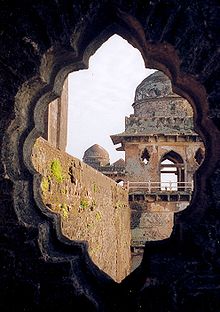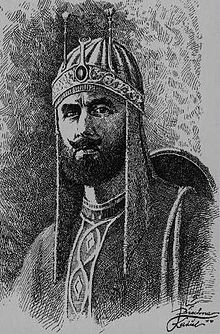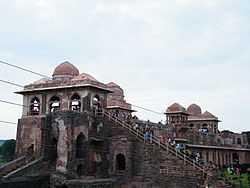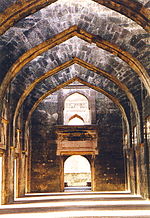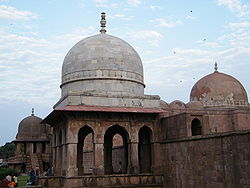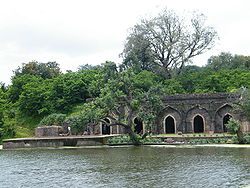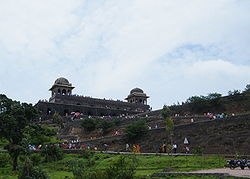- Mandu, Madhya Pradesh
-
This article is about the city in India. For the dumpling, see Mandu (dumpling).
Mandav or Mandu — town — Coordinates 22°20′7″N 75°24′57″E / 22.33528°N 75.41583°ECoordinates: 22°20′7″N 75°24′57″E / 22.33528°N 75.41583°E Country India State Madhya Pradesh Population 300,000 Time zone IST (UTC+05:30) Mandu (माण्डू مَنضُ) or Mandavgad is a ruined city in the Dhar district in the Malwa region of western Madhya Pradesh state, central India. The distance between Dhar & Mandu is about 35 km. In the 11th century, Mandu was the sub division of the Tarangagadh or Taranga kingdom . This fortress town on a rocky outcrop about 100 km (62 mi) from Indore is celebrated for its fine architecture.
History
The earliest reference to Mandu is available in the Sanskrit inscription of 555 AD, which tells that Mandu was a fortified city even in 6th century BC. It gained prominence in 10th and 11th century under the Parmars (who called it Mandavgarh), from whom the control was snatched by Khiljis in 1305.[1] Mandav or Mandu's was earlier known by the name of "Shadiabad" meaning the city of happiness (Anand Nagari), the name was given by then ruler Allauddin Khilji. Mandu city is situated at an elevation of 633 metres (2079 feet) and extends for 13 km (8.1 mi) along the crest of the Vindhya Range, overlooking the plateau of Malwa to the north and the valley of the Narmada River to the south. These acted as natural defences and Mandu was originally the fort-capital of Rajput Parmara rulers of Malwa. Towards the end of the 11th century, it came under the sway of the Taranga kingdom.
In the 10th century Mandu was founded as a fortress retreat by Raja Bhoj. It was conquered by the Muslim rulers of Delhi in 1304. When, in 1401, the Mughals captured Delhi, the Afghan Dilawar Khan, governor of Malwa, set up his own little kingdom and the Ghuri dynasty was established. And thus began Mandu's golden age.[2]
His son, Hoshang Shah, shifted the capital from Dhar to Mandu and raised it to its greatest splendour. Hoshang's son, Mohammed, the third and last ruler of Ghuri dynasty ruled for just one year He was poisoned by the militaristic Mohammed Khalji, who established the Khilji dynasty and went on to rule for the next 33 years. He was succeeded by his son, Ghiyas-ud-din in 1469 and ruled for the next 31 years. Ghiyas-ud-din was a pleasure seeker and devoted himself to women and song.[2] He had a large harem and built the Jahaz Mahal for housing the women, numbering thousands, of his harem. Ghiyas-ud-din was poisoned, aged 80, by Nasir-ud-din, his own son.
In 1526, Mahmud II the sixth Khalji ruler made no resistance against the invading Bahadur Shah of Gujarat who conquered Mandu March 28, 1531. In 1530 Humayun, the second Mughal Emperor, succeeded Babur. Babur had established the Mughal dynasty. Humayun had two major rivals: Bahadur Shah of Gujarat and Sher Shah Suri. Humayun was engaged in a war with Sher Shah Suri when he learned of an imminent attack by Bahadur Shah of Gujarat who was being aided by the Portuguese. With an unusual swiftness Humayun attacked and defeated Bahadur Shah. Thus in 1534 Mandu came under Humayun's rule. Humayun fancied Mandu so he relaxed here for a brief, peaceful interlude [3] Humayun lost the kingdom to Mallu Khan, an officer of the Khalji dynasty. Ten more years of feuds and invasions followed and in the end Baz Bahadur emerge in the top spot.[2] By this time Humayun had been defeated by Sher Shah Suri and had fled India. Sher Shah Suri died in 1545 and his son Islam Shah died in 1553. Islam Shah's 12 year old son Feroz Khan became the king but was killed by Adil Shah Suri within 3 days. Adil Shah appointed Hemu, also known as 'Hemu Vikramaditya' as his Chief of Army and Prime Minister. Hemu had a rapid rise during Sur regime. A grain supplier to Sher Shah Suri's army and then Chief of Intelligence or Daroga-i-Chowki (Superintendent of Post) under Islam Shah, he became the Prime Minister and Commander-in-Chief of the Afghan Army (Sher Shah Suri's army) under the reign of Adil Shah Suri. Adil Shah Suri was an incompetent ruler and many rebellions occurred against his rule. Hemu was sent to quell these rebellions. During this period Hemu attacked Mandu also and Baz Bahadur ran away from Mandu. Hemu appointed his own Governor here.
During this period Humayun had returned to India and in 1555 was again the emperor. In 1556 Humayun died after falling while descending a staircase.
 Mughal forces led by Adham Khan, enter the fort of Baz Bahadur of Malwa, 1561, Akbarnama ca 1590-95.
Mughal forces led by Adham Khan, enter the fort of Baz Bahadur of Malwa, 1561, Akbarnama ca 1590-95.
 The Defeat of Baz Bahadur of Malwa by the Mughal troops, while Rani Roopmati, and her female companions, view the scene from the terrace of the fort. 1561- Akbarnama, ca 1590-95
The Defeat of Baz Bahadur of Malwa by the Mughal troops, while Rani Roopmati, and her female companions, view the scene from the terrace of the fort. 1561- Akbarnama, ca 1590-95
Hemu was in Bengal at the time and sensing an opportunity attacked Mughals. Soon Agra, Bihar, Eastern UP, Madhya Pradesh were all won and on 6 October 1556 he won Delhi, defeating Akbar's forces, and had his coronation at Purana Quila, the next day. Akbar defeated and killed Hemu in the second Battle of Panipat on November 7, 1556. In 1561, Akbar's army led by Adham Khan and Pir Muhammad Khan attacked Malwa and defeated Baz Bahadur in the battle of Sarangpur on 29 March 1561. One of the reasons for Adham Khan's attack seems to be his love for Rani Roopmati. Rani Roopmati poisoned herself to death on hearing the news of fall of Mandu. Baz Bahadur fled[4] to Khandesh. Akbar, soon recalled Adham Khan and made over command to Pir Muhammad. Pir Muhammad attacked Khandesh and proceeded up to Burhanpur but he was defeated by a coalition of three powers: Miran Mubarak Shah II of Khandesh, Tufal Khan of Berar and Baz Bahadur. Pir Muhammad died while retreating. The confederate army pursued the Mughals and drove them out of Malwa. Baz Bahadur regained his kingdom for a short period. In 1562, Akbar sent another army led by Abdullah Khan, the Uzbeg, which finally defeated Baz Bahadur. He fled to Chittor. Baz Bahadur remained a fugutive at a number of courts till he surrenedered in November, 1570 to Akbar at Nagaur. He joined Akbar's service.[5]
After Akbar added Mandu to the Mughal empire, it kept a considerable degree of independence, until taken by the Marathas in 1732 by Peshwa Baji Rao I. The capital of Malwa was then shifted back to Dhar by Marathas under Maharaja Pawar, and the slide in Mandu's fortunes that had begun with the absconding of Baz Bahadur became a plummet.[2]
Places of interest
Mandu, due to its strategic position and natural defences, was an important place with a rich and varied history. It was an important military outpost and its military past can be gauged by the circuit of the battlemented wall, which is nearly 37 km (23 mi) and is punctuated by 12 gateways. The wasll encloses a large number of palaces, mosques, Jain temples of 14th century and other buildings. The oldest mosque dates from 1405; the finest is the Jama Masjid or great mosque, a notable example of Pashtun architecture. The marble domed tomb of this ruler is also magnificent
Some of the notable places are
The Darwazas/Gates
The wall encompassing Mandu has 12 major gates or darwazas. The present road, through which Mandu is reached passes through many of these. Also encountered are smaller gateways built to provide protection to the above-mentioned 12 gates.
Jahaz Mehal/Ship Palace Situated between two artificial lakes, this two storied architectural marvel is so named as it appears as a ship floating in water. Built by Sultan Ghiyas-ud-din-Khilji, it served as a harem for the sultan. It is a major tourist attraction and presents many scenic views and photographic opportunities.
Hindola Mahal
Hindola Mahal - meaning Swing palace is so named due to its sloping side walls. The Hindola Mahal might have been constructed during the reign of Hushang Shah about 1425 C.E. but may date to the end of the 15th century during the reign of Ghiyas al-Din. [6] It is one of a set buildings making up the royal palace complex at Mandu, which consists of the Jahaz Mahal, the Hindola Mahal, the Tawili Mahal, and the Nahar Jharokha.[7] The Hindola Mahal may have been used as an audience chamber.[8] There are a number of other, undated structures surrounding the palace - an evidence of the rich and glorious past.
Hoshang Shah's Tomb
India's first marble structure, it is one of the most refined examples of Afghan architecture. Its unique features include the beautifully proportioned dome, intricate marble lattice work and porticoed courts and towers. It served as a template for the construction of Taj Mahal.
Jami Masjid Inspired by the great mosque of Damascus, this humongous structure is striking in both its simplicity and architectural style-with large courtyards and grand entrances.
Rewa Kund
A reservoir constructed by Baz Bahadur for the purpose of supplying water to Rani Roopmati's Pavilion. The reservoir is situated below the pavilion and hence is considered an architectural marvel.
Roopmati's Pavilion
A large sandstone structure originally built as an army observation post it is known today as Roopmati's Pavilion. Rani Roopmati - the love interest of Baaz Bahadur lived here and is said to have gazed at the Baz Bahadur's Palace - situated below and also at Narmada river, flowing through the Nimar plains far below, a river which the queen revered. The Pavilion is a major tourist attraction and offers many scenic views.
Baz Bahadur's Palace
Built by Baz Bahadur this 16th century structure is famous for its large courtyards encompassed by large halls and high terraces. It is situated below Roopmati's Pavilion and can be seen from the pavilion.
File:Baobab Tree of Mandu.JPG
References
- ^ http://naresh-lalwani.sulekha.com/blog/post/2006/11/enchanting-rani-roopmati.htm
- ^ a b c d http://www.lonelyplanet.com/india/madhya-pradesh-and-chhattisgarh/mandu/history
- ^ The Mughal Throne by Abraham Eraly pg 47
- ^ Smith, Vincent, Arthur. Akbar the Great Mogul, 1542-1605. http://books.google.com/books?id=y_BBAAAAIAAJ&q=%22Baz+Bahadur&dq=%22Baz+Bahadur&pgis=1.
- ^ Majumdar, R.C. (ed.) (2007) The Mughul Empire, Mumbai:Bharatiya Vidya Bhavan, ISBN 81-7276-407-1, pp.112-3
- ^ Bianca Maria Alfieri, Islamic Architecture of the Indian Subcontinent (New York:te Neues Publishing Company, 2000), 131-135.
- ^ William Wilson Hunter and others, Imperial Gazetteer of India (Oxford: Clarendon Press, 1908), 186. http://books.google.com/books?id=hpEZAAAAYAAJ
- ^ Matsuo Ara, Hindla Mahal, http://www.ioc.u-tokyo.ac.jp/~islamarc/WebPage1/htm_eng/mandu1-eng.htm.
 This article incorporates text from a publication now in the public domain: Chisholm, Hugh, ed (1911). Encyclopædia Britannica (11th ed.). Cambridge University Press.
This article incorporates text from a publication now in the public domain: Chisholm, Hugh, ed (1911). Encyclopædia Britannica (11th ed.). Cambridge University Press.
Cities and towns in Indore Division Alirajpur district Barwani district Burhanpur district Dhar district Indore district Jhabua district Khandwa district Khargone district Related topics Cities and towns
in other DivisionsCategories:- Forts in Madhya Pradesh
- Tourism in Madhya Pradesh
- Cities and towns in Dhar district
- Cities in Malwa
- Former populated places in India
- Former Indian capital cities
- Dhar district
Wikimedia Foundation. 2010.



